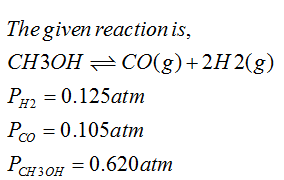3a) Calculate AG for this reaction: CH,OH (g) +→ CO (g) + 2 H; (g) The equilibrium partial pressures for each component are: CH;OH = 0.620 atm, CO = 0.105 atm, H2 = 0.125 atm
3a) Calculate AG for this reaction: CH,OH (g) +→ CO (g) + 2 H; (g) The equilibrium partial pressures for each component are: CH;OH = 0.620 atm, CO = 0.105 atm, H2 = 0.125 atm
Chemistry
10th Edition
ISBN:9781305957404
Author:Steven S. Zumdahl, Susan A. Zumdahl, Donald J. DeCoste
Publisher:Steven S. Zumdahl, Susan A. Zumdahl, Donald J. DeCoste
Chapter1: Chemical Foundations
Section: Chapter Questions
Problem 1RQ: Define and explain the differences between the following terms. a. law and theory b. theory and...
Related questions
Question

Transcribed Image Text:AutoSave
CHEM 212 Final Exam_Fall 2020
Word
Search
困
ff
steve M
SM
File
Home
Insert
Draw
Design
Layout
References
Mailings
Review
View
Help
E Share
O Comments
3a) Calculate AGon for this reaction:
CH3OH (g) → CO (g) + 2 H2 (g)
The equilibrium partial pressures for each component are:
CH;OH = 0.620 atm, CO = 0.105 atm, H2 = 0.125 atm
b) Is the reaction spontaneous? Briefly explain.
3c) Cells use the hydrolysis of adenosine triphosphate (ATP) as a source of energy. The
conversion of ATP to ADP has a standard free energy change of -30.5 kJ/mol. If all the free
energy from the metabolism of glucose goes to the conversion of ADP to ATP, how many mole
of ATP can be produced for each mole of glucose?
Page 3 of 6
492 words
D Focus
80%
Expert Solution
Step 1

Step 2

Step by step
Solved in 3 steps with 3 images

Knowledge Booster
Learn more about
Need a deep-dive on the concept behind this application? Look no further. Learn more about this topic, chemistry and related others by exploring similar questions and additional content below.Recommended textbooks for you

Chemistry
Chemistry
ISBN:
9781305957404
Author:
Steven S. Zumdahl, Susan A. Zumdahl, Donald J. DeCoste
Publisher:
Cengage Learning

Chemistry
Chemistry
ISBN:
9781259911156
Author:
Raymond Chang Dr., Jason Overby Professor
Publisher:
McGraw-Hill Education

Principles of Instrumental Analysis
Chemistry
ISBN:
9781305577213
Author:
Douglas A. Skoog, F. James Holler, Stanley R. Crouch
Publisher:
Cengage Learning

Chemistry
Chemistry
ISBN:
9781305957404
Author:
Steven S. Zumdahl, Susan A. Zumdahl, Donald J. DeCoste
Publisher:
Cengage Learning

Chemistry
Chemistry
ISBN:
9781259911156
Author:
Raymond Chang Dr., Jason Overby Professor
Publisher:
McGraw-Hill Education

Principles of Instrumental Analysis
Chemistry
ISBN:
9781305577213
Author:
Douglas A. Skoog, F. James Holler, Stanley R. Crouch
Publisher:
Cengage Learning

Organic Chemistry
Chemistry
ISBN:
9780078021558
Author:
Janice Gorzynski Smith Dr.
Publisher:
McGraw-Hill Education

Chemistry: Principles and Reactions
Chemistry
ISBN:
9781305079373
Author:
William L. Masterton, Cecile N. Hurley
Publisher:
Cengage Learning

Elementary Principles of Chemical Processes, Bind…
Chemistry
ISBN:
9781118431221
Author:
Richard M. Felder, Ronald W. Rousseau, Lisa G. Bullard
Publisher:
WILEY